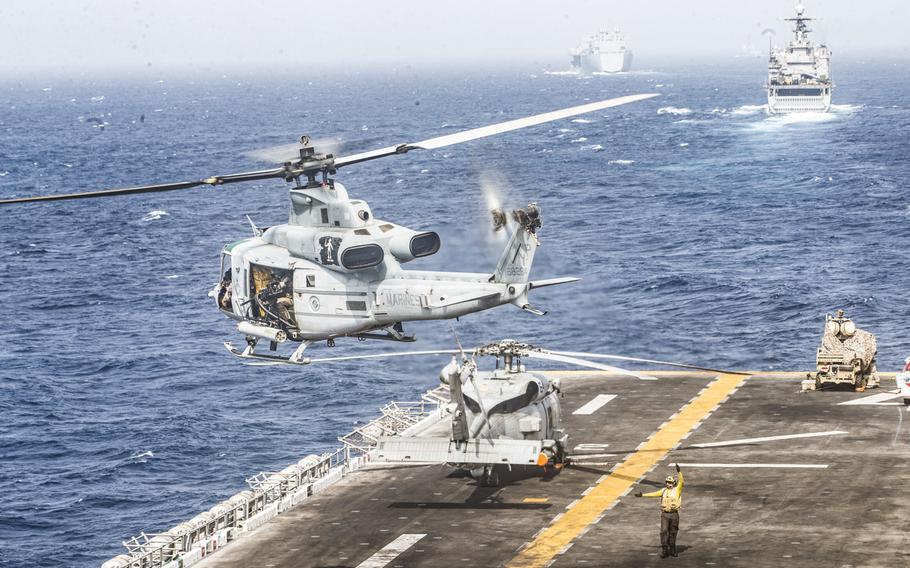
A helicopter takes off from the flight deck of the amphibious assault ship USS Boxer as it transits through the Strait of Hormuz on Thursday, July 18, 2019, the day the U.S. Navy destroyed a drone that flew within 1,000 meters of the assault ship. Dalton Swanbeck/U.S. Marine Corps ()
MANAMA, Bahrain — Iranian officials denied Friday that a U.S. Navy ship had destroyed an Iranian drone in the Strait of Hormuz this week, following statements a day earlier from the White House and the Pentagon that the drone was taken down after flying toward the ship.
Senior Iranian officials said that none of the country’s drones in the region had been destroyed, although a top military spokesman in the country suggested that one had approached the USS Boxer, the American amphibious assault ship at the center of the incident.
President Donald Trump said Thursday that the U.S. ship was in international waters, traveling into the strait, when a drone came within about 1,000 meters of it. The unmanned aircraft ignored “multiple calls to stand down” and “was immediately destroyed,” Trump said, adding that the drone was “threatening the safety of the ship and the ship’s crew.”
Trump said the drone was Iranian. Pentagon spokeswoman Cmdr. Rebecca Rebarich said separately that it “was assessed to be Iranian.”
Calling Trump’s claims “delusional and groundless,” Iran’s Brig. Gen. Abolfazl Shekarchi told the semi-official Mehr news agency on Friday that all of Iran’s drones in the area, “including the one mentioned by the U.S. president,” had returned safely to their bases after completing scheduled surveillance and control operations.
Iran’s deputy foreign minister posited in a tweet on Friday that the American warship may have downed a U.S. unmanned aircraft system.
“We have not lost any drone in the Strait of Hormuz nor anywhere else,” Seyyed Abbas Araghchi said. “I am worried that USS Boxer has shot down their own UAS by mistake!”
The Boxer, which carries the 11th Marine Expeditionary Unit and a combat helicopter squadron, arrived in Middle East waters in late June with the amphibious transport dock USS John P. Murtha and the amphibious dock landing ship USS Harpers Ferry, the Navy has said.
The amphibious ready group replaced another led by the USS Kearsarge, which had been in 5th Fleet waters since April.
The drone “closed within a threatening range” of the ship at about 10 a.m. local time on Thursday, Jonathan Hoffman, chief Pentagon spokesman, said in a statement.
“The ship took defensive action against the [drone] to ensure the safety of the ship and its crew,” Hoffman said.
U.S. Marines aboard the USS Boxer used “counter-drone jamming equipment” to take down the drone, CNN reported, citing a U.S. official.
A military photo taken Thursday of the ship’s flight deck shows a Marine Corps MRZR all-terrain vehicle outfitted with the Light Marine Air Defense Integrated System, which is able to scan the sky to detect hostile drones and jam them.
The USS Boxer incident comes about a month after Iran shot down a costly U.S. spy drone with a surface-to-air missile, further raising tensions in the region. The U.S. has denied Tehran’s claims that the drone was operating in Iranian airspace.
Earlier this year, the Pentagon announced plans to send some 2,000 troops to the Middle East to bolster security for American personnel and interests in the region.
News of the deployments followed a White House announcement that it had ordered the USS Abraham Lincoln Carrier Strike Group, along with a B-52 bomber task force, to the region, citing unspecified Iranian threats in May.
The Trump administration reimposed sanctions on Iran last year, months after pulling the United States out of a 2015 international agreement under which economic sanctions were lifted in exchange for Iran limiting sensitive nuclear activities and allowing in international inspectors. Trump has said he wants to renegotiate what he has called a “horrible” deal.
Thursday’s drone incident came as the U.S. Treasury and State departments announced sanctions against companies and their agents who they said were involved in procuring “sensitive materials” for Iran’s nuclear program.
Tehran, which has protested the pressure campaign and called U.S. troops in the region terrorists, has said it would increase its uranium enrichment beyond levels allowed under the nuclear accord. It has also threatened to block the Strait of Hormuz, a major shipping thoroughfare for oil.
Since May, six oil tankers have been damaged in attacks in the Gulf of Oman, which lies to the east of the strait and the Persian Gulf, and flows into the Arabian Sea. The United States has blamed Iran for the attacks but Tehran has denied any involvement.
U.S. Central Command last month accused Iran of attempting to shoot down a U.S. MQ-9 Reaper drone that had arrived over one of the damaged merchant ships as it burned in the Gulf of Oman. CENTCOM also alleged that there were indications that Iran played a role in the shoot-down of a Reaper by Houthi rebels in Yemen earlier in June.
U.S. defense officials were seeking to form a coalition to protect merchant ships in the region, the Pentagon’s top general said last week. The U.S. would provide intelligence and other support, but not escorts for commercial vessels, Marine Gen. Joseph Dunford, chairman of the Joint Chiefs of Staff, told reporters in Washington.
Days later, a British warship in the Persian Gulf prevented three Iranian patrol boats from intercepting a British merchant ship as it was entering the strait.
Trump called Thursday’s drone incident “the latest of many provocative and hostile actions by Iran against vessels operating in international waters.” He urged other nations to work with the U.S. and protect their ships going through the strait.
kenney.caitlin@stripes.com Twitter: @caitlinmkenney
garland.chad@stripes.com Twitter: @chadgarland